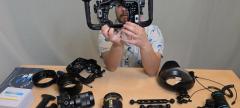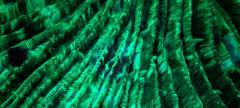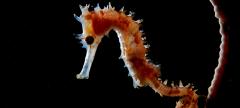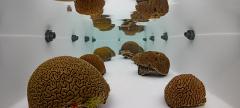Ocean Art Photo Competition 2020 Judges Comments
The Ocean Art Underwater Photo Competition is one of the most prestigious underwater photo contests in the world, attracting some of the world's most talented photographers. This year 12 different categories ensured a fun competition for all camera classes and disciplines of underwater photography.
If you haven't yet, be sure to check out the 2020 Ocean Art Contest Winners.
Ocean Art would not be possible without our esteemed judging panel, who has decades of experience and some of the most prestigious awards in the diving, photo, and video industries.
Here is what our judges had to say about this year's competition.
Marty Snyderman

The author of Dive Training magazine's Behind the Lens column, Marty Snyderman has made his living as an underwater photographer, photography instructor, author, and speaker for close to 40 years. He has won many prestigious awards (including an Emmy) and has been featured in many top publications worldwide.
For starters, I would like to thank everyone that entered an image in the 2020 Ocean Art Photography Contest. I would also like to offer my congratulations to the Best of Show winner, all of the category winners, those that placed, and those that received an honorable mention. Well done! You deserve to be proud of the recognition you receive. I assure you, there were a lot of superb images in this contest.
As has been the case for many years running, the technical quality of the submitted images continued to improve and many photographs caused me to feel a pang of jealousy. The images came from all over the diving world, and the variety of subject matter served to intensify the competition.
Although I disagreed at times with my fellow judges, I have nothing but respect for their skill as photographers, as judges, and for the seriousness with which they take their responsibilities as judges. Tony and Mark are a pleasure to work with, and any disagreements we had simply illustrate that even though we are all professional underwater photographers, we have different styles and tastes, and judging is subjective.
Please know that if you entered the contest, but did not have an image that was recognized, there is absolutely no reason in the world to be disappointed with your work. There were numerous images that made one judge or another say something like “I wish that was my shot”, and not all of those photographs were honored in the end.
With regard to any observations and suggestions I might have for anyone entering a contest in the future, I offer the following: Be sure you understand the criteria for each category and abide by the rules. I suggest that you avoid entering similar images, especially similar images in the same category. When that happens, you end up competing against yourself and asking the judges to do your editing. Be very careful about over sharpening and getting too heavy-handed with the vibrance, saturation, and contrast tools in post-production. Quite a few images were not as favorably judged as they might have been if the photographer not over used these tools.
Lastly, I suggest that you pay attention to whatever advice Mark and Tony have to offer. Those guys are pros’ pros.
Please enter again next year. I think I am speaking for all of the judges when I say that we thoroughly enjoy seeing your work and found the images to be very inspiring. Thank you for that!
Here’s to a Happy, Healthy, Safe, Photography-Filled 2021 for All!
Mark Strickland
Mark Strickland has done over 10,000 dives and had careers as lifeguard, boat captain, scuba instructor and cruise director. He’s been passionate about underwater photography all his adult life and leads several photo expeditions each year for Bluewater. Mark’s work has appeared in many publications around the world, and has been displayed at the Smithsonian Institution and United Nations Visitor Center as well as several renowned galleries.
https://www.markstrickland.com/
First, to all who participated, thank you. Whether your images were officially recognized or not, just by participating, you are helping to spread awareness about the beauty and fragility of the underwater realm. Beyond that, competitions like Ocean Art also serve as great inspiration to your fellow underwater shooters, including the judges of this contest.
It was a huge honor to work with such highly accomplished judges as Marty and Tony, each of whom are superstars in the underwater photography world, but thankfully are too humble to act that way. Having had limited involvement in previous competitions, I was excited to be asked, and hope to have lived up to the expectations that a contest of this caliber warrants.
From the beginning, I was struck by the amazing number of quality images in every category. And, continuing a trend in recent years, many outstanding photos were taken with compact cameras. Of course high-end mirrorless and DSLR systems still have an edge, but as compacts continue to improve, those advantages no longer seem like night and day. Compact shooters are now able to capture images that were formerly impossible with modestly-priced systems. Not only does this encourage more people to participate, I think it also serves to de-emphasize the importance of certain technical specifications, encouraging all underwater shooters to concentrate more on the actual art of underwater photography.
Due to the huge volume of outstanding images, I found it exceedingly difficult to limit my selections to the relative few that would go on to the next round of judging. Photos with obvious technical problems were easy to eliminate, but we soon reached a point where every remaining image had widespread appeal. Even in Round 1, I found myself despairing over having to eliminate images that were only slightly less impressive than those advancing to the next round. Soon, there was no longer any question about whether an image was aesthetically pleasing and technically correct; now came the even harder but necessary decisions, eliminating yet more images that were merely excellent, in order to save room for those truly outstanding ones that would become finalists.
While we judges have years of underwater imaging experience and probably admire many of the same photos taken by our peers, the art of photography is still very subjective, so naturally we found ourselves disagreeing on certain images. Of course such debates add to the time and effort required to complete the judging, but are an essential part of the process, allowing each judge to consider different points of view and aesthetic sensibilities. Thanks to these interactions, I think we all gained perspective that made for a truly collaborative process, ultimately resulting in a selection of winners that we are all proud to have chosen.
For anyone considering future competitions, a few suggestions come to mind. Read the rules thoroughly. Think carefully about the most appropriate category for each image. Just because a photo was taken with a wide lens doesn’t mean it must go in the wide-angle category, especially if it depicts great behavior or a strong environmental message. Resist the urge to over-process; we saw many otherwise great photos ruined by such heavy-handedness, especially with vibrance, dehaze and sharpening. If possible, calibrate your display before adjusting images, so that they look the same on the judges’ screens as they do on yours. Take advantage of allowable editing such as minor cropping and tonal adjustment, as there were many potentially great images that could not be chosen because these simple edits had been omitted. And, while it’s fine to admire the work of others and emulate certain techniques and approaches, strive to create something new and different, rather than just copying someone else’s successful efforts.
To those whose images were honored this year, congratulations! Not only will you be taking home some great prizes, but perhaps more significantly, you can take great pride in having your work chosen out of an extremely competitive field that includes some of the world’s most accomplished underwater shooters.
If you entered but didn't place, do not be discouraged. With so many exceptional images being entered and the highly subjective nature of judging, it’s normal that a bunch of great, potentially prize-winning images went without recognition. It happens with every major contest, and is just the nature of such events. So, if you have images that you’re proud of and feel are well suited for other contests, I encourage you to enter them. And whether you’re out to win or simply enjoy sharing images with friends and family, remember that satisfaction comes not only from capturing great images, but also the broader experience of being an underwater photographer. So embrace the entire process, from researching future dive locales to familiarizing yourself with potential subjects and behaviors, to fine-tuning your equipment and techniques. Seek out a new destination or revisit an old favorite, take time to chat with local people, and enjoy the whole experience. When you encounter difficulties, whether it involves dive conditions or equipment, remember that this, too, is part of the experience, and will help you grow as a photographer.
Wishing everyone a happy, healthy and rewarding 2021, hopefully including lots of time below the waves!
Tony Wu

Author of a coffee table book entitled Silent Symphony, which received the grand prize for best book of the year at Antibes in 2001. He has also won both the Underwater and Mammal Behaviour categories of the Wildlife Photographer of the Year competition
Looking through the images submitted to the contest was a nice surprise. With various lockdowns and other restrictions on travel during 2020, receiving a wide range of high quality entries was not a foregone conclusion. But the quality did not suffer.
As has been the case each year, the conversation with fellow judges—in this instance Marty and Mark—was both fun and vexing. Fun because Marty and Mark are great people, vexing because it was not possible for each judge to prevail in each discussion. Differences of view, give-and-take are an inherent part of any subjective process. I think it fair to say though, that we were all very happy with the final outcome. Congratulations to all the recognized images!
If your entry was not selected, please do not be discouraged. Rather, look through the winning images and think about why we selected any given image. I can tell you that the personal preferences and photographic views of the three of us differ in many respects. Selected images therefore had to appeal to at least two of us, and not have any strong objection from the third.
While there is no exact formula for what images are or are not likely to be considered strong candidates for selection, there were, as in past years, certain recurring themes. I will highlight a few.
Anything unique, whether subject or photographic technique/ style, is almost always good. I qualify with “almost,” because novelty in itself doesn’t automatically make something good. A dud photograph of a never-before photographed animal is still a dud photograph. This matters in a photo competition.
In today’s digital world, computer skills are as important as camera skills. In practical terms, processing software like Lightroom or Photoshop should be used just enough to reflect the scene in an accurate manner, without crossing the line into exaggeration. The issue that arises most frequently in this regard is the over-use of saturation. It can be tempting to crank the saturation (and/ or vibrance), but just because a slider exists in software doesn’t mean that it needs to abused, especially with nature photography. Where to draw the line is subjective, but if the result looks like a bad acid trip, dial it back.
Having multiple elements in an image is always a plus. The overall winner “The Day of the Tentacles” is a perfect example. I do not like circular fisheye images. No logical reason. Just personal taste. But the moment I saw this image, I loved it. Why? The main subject is an octopus, but you don’t see the literal octopus. You see suckers and arms, which are arguably the defining characteristics of an octopus. You see the arms and suckers exploring and tasting the dome port, which is quintessential octopus behavior. There is symmetry in placement of the octopus arms. The colors align with R-G-B spectrum. And finally—this is the kicker—there are people visible in the window created by the framing of the octopus’s arm. I did not know who the people were when I saw the image, but there is a connotation of mother and child, or other strong bond, with the adult pointing toward the octopus and photographer, child looking on. The interest of the child mirrors the interest of the octopus.
In other words, on top of a technically well-executed photo, there is a story there, one that involves both animal and humans. (Reading the Story of the Shot just now, it sounds as if the octopus took the photo itself, which would be even more interesting.)
Back to the Ocean Art 2020 Winners page

RECOMMENDED ARTICLES
SUPPORT THE UNDERWATER PHOTOGRAPHY GUIDE:
The Best Service & Prices on u/w Photo Gear
 Visit Bluewater Photo & Video for all your underwater photography and video gear. Click, or call the team at (310) 633-5052 for expert advice!
Visit Bluewater Photo & Video for all your underwater photography and video gear. Click, or call the team at (310) 633-5052 for expert advice!
The Best Pricing, Service & Expert Advice to Book your Dive Trips
 Bluewater Travel is your full-service scuba travel agency. Let our expert advisers plan and book your next dive vacation. Run by divers, for divers.
Bluewater Travel is your full-service scuba travel agency. Let our expert advisers plan and book your next dive vacation. Run by divers, for divers.































